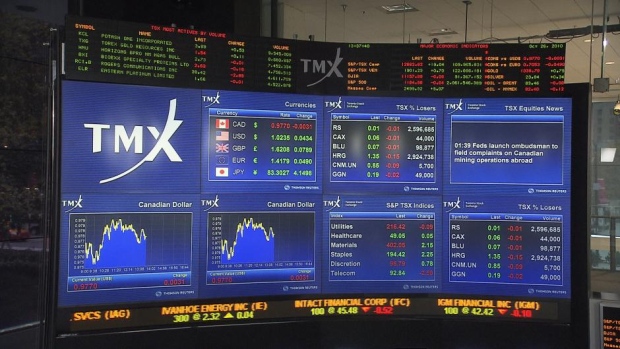Jan 3, 2017
TSX, Wall Street close higher on first trading day of 2017
, The Canadian Press

TORONTO -- The Toronto stock market ushered in the new year Tuesday by racking up a solid three-digit gain, driven by a rise in gold and metals stocks, and signs that the Chinese economy is growing.
The S&P/TSX composite index soared 115.44 points at 15,403.03 after being closed since Friday for the New Year's Day holiday observed on Monday.
Gold stocks were the leading advancer on the index, climbing nearly seven per cent, as big-named miners like Barrick Gold Corp. (ABX.TO) and Iamgold Corp. (IMG.TO) gained 2.56 per cent and 6.74 per cent, respectively. The February bullion contract was up $10.30 at US$1,162 an ounce.
The bull market also extended to New York, where the Dow Jones industrial average added on 119.16 points to 19,881.76, the S&P 500 rose 19 points to 2,257.83 and the Nasdaq composite jumped 45.96 points to 5,429.08.
Craig Fehr, a Canadian markets strategist at Edward Jones, said traders are keen on keeping the optimism in equity markets going into 2017. North American stock indexes have risen steadily since the U.S. election in early November.
Fehr noted that investors continued to be buoyed by what the future will hold with Donald Trump as U.S. president, a position he will assume on Jan. 20.
Trump's impact on less regulation in the pharmaceutical and banking sectors, as well as his promise of more money for infrastructure, has the potential to drive stocks higher at the end of this year and into 2018, he said.
In U.S. economic news, the Institute for Supply Management said its manufacturing index rose to 54.7 in December, its highest reading of the year and the fourth straight month of expansion. Anything above 50 signals growth.
The ISM results were a bit stronger than analysts expected.
The Canadian dollar showed some weakness, falling back 0.04 of a U.S. cent to 74.44 cents US, as the U.S. dollar strengthened following the release of the data.
Overseas, in China, the Caixin manufacturing purchasing managers' index advanced in December at its fastest rate in three years. The index stood at 51.9, higher than market forecasts of 50.7.
In commodities, the February crude contract pulled back $1.39 to US$52.33 per barrel, as investors surveyed the impact of production cuts agreed on by OPEC and non-OPEC members coming into effect on Jan. 1.
Oil prices had risen quickly at the start of the session but fell by mid-day.
"It's reality setting in. These [OPEC and non-OPEC] countries have to actually execute in terms of these freezes or these cuts," said Fehr. "Markets are going to be a little more hesitant until there is some more evidence that indeed these countries are going to be living by the terms of the agreement."
February natural gas was down sharply, declining 40 cents at US$3.33 per mmBTU, while March copper contracts were down two cents at US$2.49 per pound.
With files from The Associated Press






